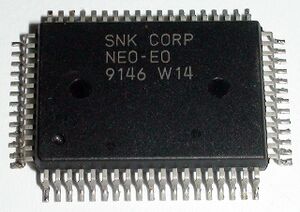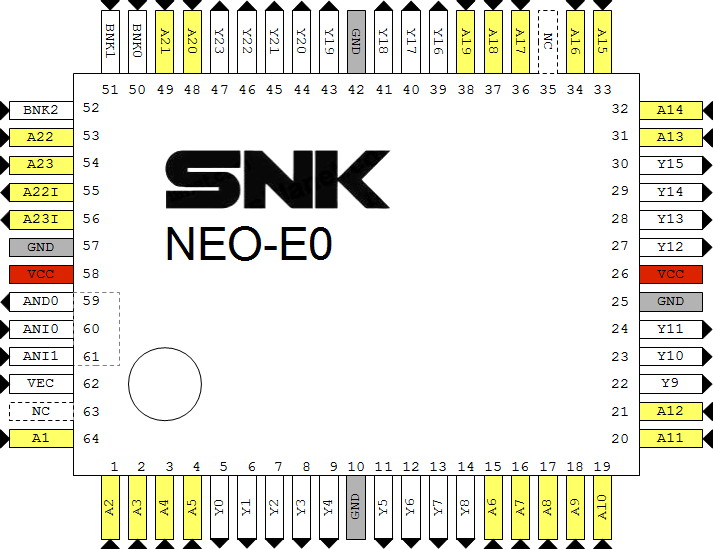NEO-E0: Difference between revisions
Jump to navigation
Jump to search
mNo edit summary |
No edit summary |
||
| Line 1: | Line 1: | ||
[[File:aes_e0.jpg|right|thumb|NEO-E0 chip found on a AES board.]] | [[File:aes_e0.jpg|right|thumb|NEO-E0 chip found on a AES board.]] | ||
Also found | Also found on MVS boards, even those without memory card slots. | ||
BIOS vector table swapping | ==BIOS vector table swapping== | ||
When 68k A8~A23 = 0 and the [[BIOSes|BIOS]'s vector table is chosen (by using [[memory mapped registers#System registers|"system" memory mapped registers]]), A22I~A23I outputs are set to 1. This makes the address appear to address decoding chips as a BIOS access instead of a [[P ROM]] access. | |||
==Memory card address latch== | |||
On AES systems, BNK0~BNK2 are tied low. This makes the chip act just like a buffer ? | |||
What are BNK0~BNK2 used for ? | |||
The chip also ANDs the pair of 8bit output enable signals from the [[NEO-C1]] since there is only a single 16bit ROM used for the BIOS. | |||
=Pinout= | |||
[[File:Neo-e0_pinout.png]] | |||
*A1~A23: 68k address bus | |||
*Y0~Y23: memory card address bus | |||
*BNK0~BNK2: comes from [[NEO-D0]], ? | |||
*VEC: BIOS vector table swapping enable | |||
*ANI0, ANI1, AND0: AND gate used to generate ROMOE from ROMOEU and ROMOEL | |||
[[Category:Chips]] | [[Category:Chips]] | ||
Revision as of 18:32, 25 March 2011

Also found on MVS boards, even those without memory card slots.
BIOS vector table swapping
When 68k A8~A23 = 0 and the [[BIOSes|BIOS]'s vector table is chosen (by using "system" memory mapped registers), A22I~A23I outputs are set to 1. This makes the address appear to address decoding chips as a BIOS access instead of a P ROM access.
Memory card address latch
On AES systems, BNK0~BNK2 are tied low. This makes the chip act just like a buffer ? What are BNK0~BNK2 used for ?
The chip also ANDs the pair of 8bit output enable signals from the NEO-C1 since there is only a single 16bit ROM used for the BIOS.
Pinout
- A1~A23: 68k address bus
- Y0~Y23: memory card address bus
- BNK0~BNK2: comes from NEO-D0, ?
- VEC: BIOS vector table swapping enable
- ANI0, ANI1, AND0: AND gate used to generate ROMOE from ROMOEU and ROMOEL
